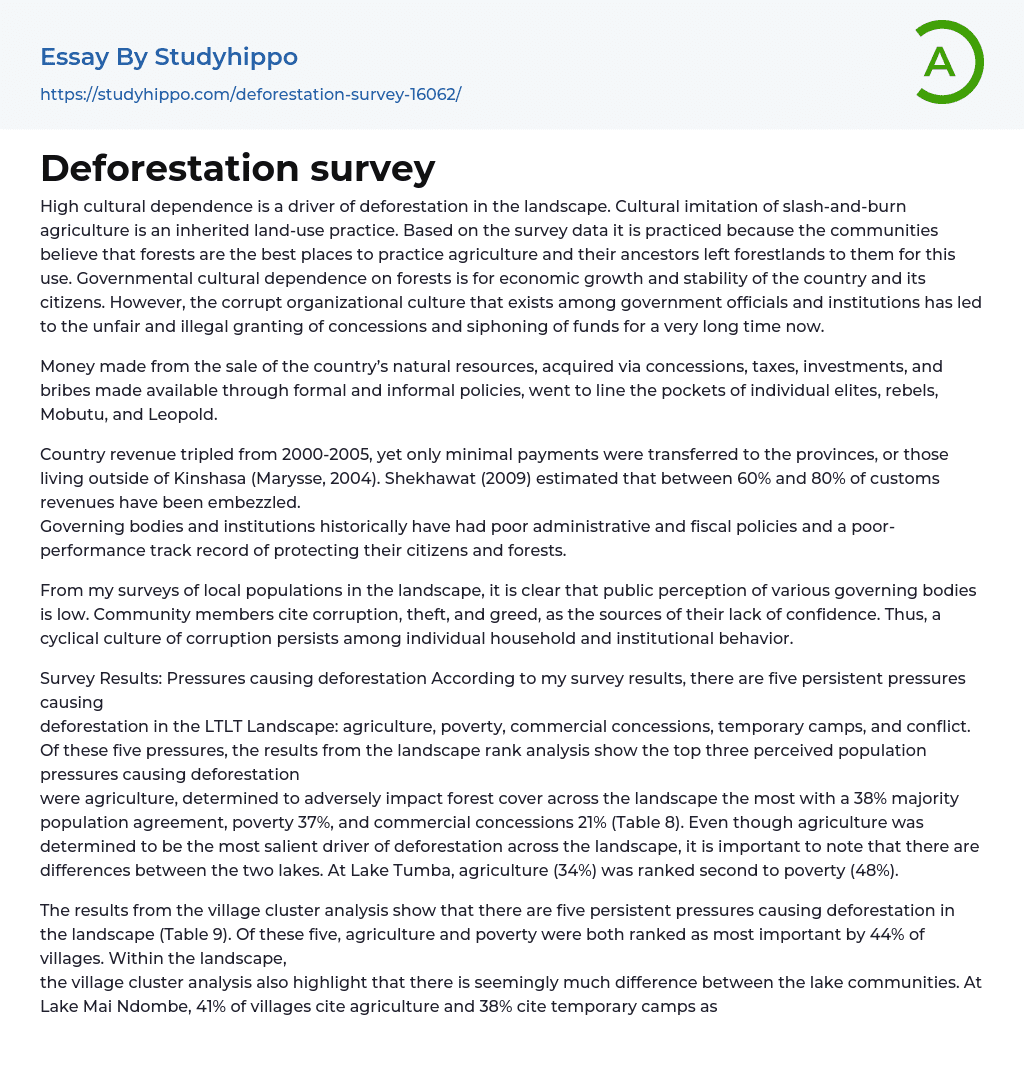High cultural dependence is a driver of deforestation in the landscape. Cultural imitation of slash-and-burn agriculture is an inherited land-use practice. Based on the survey data it is practiced because the communities believe that forests are the best places to practice agriculture and their ancestors left forestlands to them for this use. Governmental cultural dependence on forests is for economic growth and stability of the country and its citizens. However, the corrupt organizational culture that exists among government officials and institutions has led to the unfair and illegal granting of concessions and siphoning of funds for a very long time now.
Money made from the sale of the country’s natural resources, acquired via concessions, taxes, investments, and bribes made available through formal and informal policies, went to line the pockets of individual elites, rebels, Mobutu, and Leopold.
Country revenue tripled from 2000-2005, yet only minimal
... payments were transferred to the provinces, or those living outside of Kinshasa (Marysse, 2004). Shekhawat (2009) estimated that between 60% and 80% of customs revenues have been embezzled.
Governing bodies and institutions historically have had poor administrative and fiscal policies and a poor-performance track record of protecting their citizens and forests.
From my surveys of local populations in the landscape, it is clear that public perception of various governing bodies is low. Community members cite corruption, theft, and greed, as the sources of their lack of confidence. Thus, a cyclical culture of corruption persists among individual household and institutional behavior.
Survey Results: Pressures causing deforestation According to my survey results, there are five persistent pressures causing
deforestation in the LTLT Landscape: agriculture, poverty, commercial concessions, temporary camps, and conflict. Of these five pressures, the results fro
the landscape rank analysis show the top three perceived population pressures causing deforestation
were agriculture, determined to adversely impact forest cover across the landscape the most with a 38% majority population agreement, poverty 37%, and commercial concessions 21% (Table 8). Even though agriculture was determined to be the most salient driver of deforestation across the landscape, it is important to note that there are differences between the two lakes. At Lake Tumba, agriculture (34%) was ranked second to poverty (48%).
The results from the village cluster analysis show that there are five persistent pressures causing deforestation in the landscape (Table 9). Of these five, agriculture and poverty were both ranked as most important by 44% of villages. Within the landscape,
the village cluster analysis also highlight that there is seemingly much difference between the lake communities. At Lake Mai Ndombe, 41% of villages cite agriculture and 38% cite temporary camps as major pressures, whereas at Lake Tumba 67% of villages cite poverty and 42% cite conflict as highly pressuring forests. Using the same rank scale, only 16% or 4 villages identified commercial concessions as a salient pressure causing deforestation within the landscape.
References
- Change, A. (2017). Analysis of Forest Cover Change — Thepoetrytrust. [online] Thepoetrytrust. Available at: https://thepoetrytrust.org/analysis-forest-cover-change-essay [Accessed 20 Jul. 2017].
- Santilli, M., Moutinho, P., Schwartzman, S., Nepstad, D., Curran, L. and Nobre, C. (2017). Tropical Deforestation and the Kyoto Protocol.
- Classical Mechanics essays
- Rail Transport essays
- Tata Motors essays
- Vehicle Brands essays
- trucks essays
- Auto Racing essays
- Harley-Davidson essays
- Suzuki essays
- Lexus essays
- Mercedes-Benz essays
- Accounting essays
- Marketing essays
- Automation essays
- Business Cycle essays
- Business Model essays
- Business Operations essays
- Business Software essays
- Corporate Social Responsibility essays
- Infrastructure essays
- Logistics essays
- Manufacturing essays
- Multinational Corporation essays
- Richard Branson essays
- Small Business essays
- Cooperative essays
- Family Business essays
- Human Resource Management essays
- Sales essays
- Market essays
- Online Shopping essays
- Selling essays
- Strategy essays
- Management essays
- Franchising essays
- Quality Assurance essays
- Business Intelligence essays
- Corporation essays
- Stock essays
- Shopping Mall essays
- Harvard Business School essays
- Harvard university essays
- Trade Union essays
- Cooperation essays
- News Media essays
- Waste essays
- Andrew Carnegie essays
- Inventory essays
- Customer Relationship Management essays
- Structure essays
- Starting a Business essays




